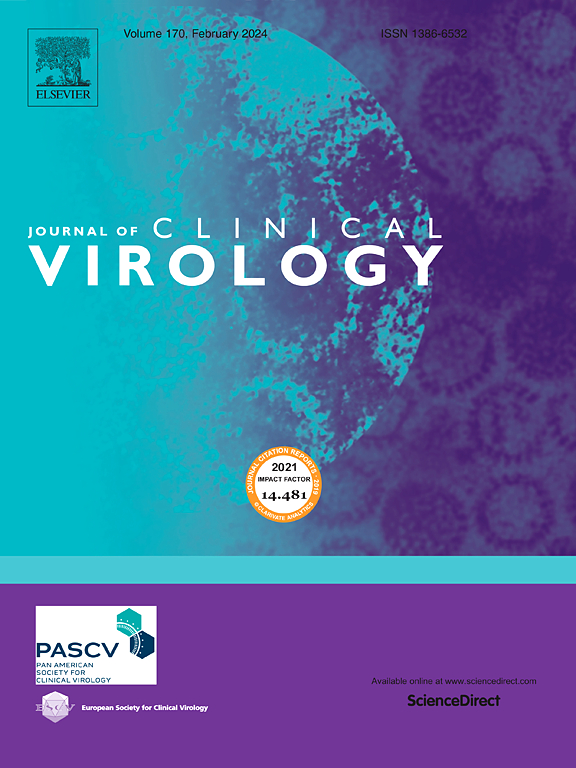Assessing sample adequacy and clinical performance of self-collected and clinician-collected HPV specimens using internal control Ct values
IF 3.4
3区 医学
Q2 VIROLOGY
引用次数: 0
Abstract
Background
Human papillomavirus (HPV) testing is the primary method for cervical cancer screening, but reliable detection depends on adequate sample cellularity. Cycle threshold (Ct) values for the assay’s internal control (IC), such as β-globin, are commonly used as proxies for adequacy, yet standardized Ct cut-offs are lacking. We aimed to contribute evidence-based thresholds for sample adequacy using real-world data.
Methods
We analyzed 237,853 clinician-collected and self-collected samples tested with the BD Onclarity™ HPV Assay between 2022 and 2024. β-globin Ct values were assessed by HPV status to evaluate adequacy. Histologically confirmed CIN2+ outcomes were linked via the National Cervical Screening Registry to assess clinical performance.
Results
Among 110,482 clinician-taken samples, 73.63 % (81,350) were HPV negative; 74.32 % (60,457) of these had β-globin Ct ≤28, and only 1.28 % exceeded Ct 32.1. In 127,390 self-collected samples, 83.47 % (106,329) were HPV negative; 99.66 % (105,967) had Ct ≤28 and only 0.06 % exceeded Ct 32.1. HPV positivity declined gradually beyond Ct 26 and more markedly above Ct 28. CIN2+ cases (n = 5546) were rarely HPV negative (n = 73), and these showed low β-globin Ct values, indicating adequate cellularity. Self-collected samples had significantly lower Ct values than clinician-taken ones (median 21.5 vs. 26.5; p < 2.2e-16), likely due to lower resuspension volume.
Conclusions
Both clinician- and self-collected samples showed adequate cellularity, with potentially false negative HPV results from low cellular content appearing rare. Observed patterns suggest Ct <26 as optimal and Ct <28 as a minimum for program-level quality assurance with the BD Onclarity™ HPV Assay.
使用内部控制Ct值评估自行采集和临床采集的HPV标本的样本充分性和临床表现
人乳头瘤病毒(HPV)检测是宫颈癌筛查的主要方法,但可靠的检测取决于足够的样本细胞。循环阈值(Ct)的测定的内部控制(IC),如β-珠蛋白,通常被用作充分性的代理,但标准化的Ct截止缺乏。我们的目的是利用真实世界的数据为样本充分性提供基于证据的阈值。方法:我们分析了2022年至2024年间237,853例临床采集和自采集的样本,并进行了BD Onclarity™HPV检测。通过HPV状态评估β-珠蛋白Ct值以评估其充分性。组织学证实的CIN2+结果通过国家宫颈筛查登记来评估临床表现。结果110,482例临床样本中,73.63 %(81,350例)为HPV阴性;其中74.32 %(60,457)的β-珠蛋白Ct≤28,只有1.28 %的β-珠蛋白Ct超过32.1。在127,390份自行采集的样本中,83.47 %(106,329)为HPV阴性;99.66 %(105,967)的Ct≤28,只有0.06 %超过Ct 32.1。HPV阳性在Ct 26后逐渐下降,而在Ct 28后更为明显。CIN2+病例(n = 5546)很少HPV阴性(n = 73),这些病例显示低β-珠蛋白Ct值,表明细胞充足。自采样本的Ct值明显低于临床采集的Ct值(中位数21.5 vs. 26.5; p < 2.2e-16),可能是由于重吸量较低。结论临床和自我收集的样本都显示足够的细胞含量,由于细胞含量低而导致潜在的假阴性HPV结果很少见。观察到的模式表明,对于BD Onclarity™HPV检测,Ct <;26是最佳的,Ct <;28是项目级质量保证的最低值。
本文章由计算机程序翻译,如有差异,请以英文原文为准。
求助全文
约1分钟内获得全文
求助全文
来源期刊

Journal of Clinical Virology
医学-病毒学
CiteScore
22.70
自引率
1.10%
发文量
149
审稿时长
24 days
期刊介绍:
The Journal of Clinical Virology, an esteemed international publication, serves as the official journal for both the Pan American Society for Clinical Virology and The European Society for Clinical Virology. Dedicated to advancing the understanding of human virology in clinical settings, the Journal of Clinical Virology focuses on disseminating research papers and reviews pertaining to the clinical aspects of virology. Its scope encompasses articles discussing diagnostic methodologies and virus-induced clinical conditions, with an emphasis on practicality and relevance to clinical practice.
The journal publishes on topics that include:
• new diagnostic technologies
• nucleic acid amplification and serologic testing
• targeted and metagenomic next-generation sequencing
• emerging pandemic viral threats
• respiratory viruses
• transplant viruses
• chronic viral infections
• cancer-associated viruses
• gastrointestinal viruses
• central nervous system viruses
• one health (excludes animal health)
 求助内容:
求助内容: 应助结果提醒方式:
应助结果提醒方式:


